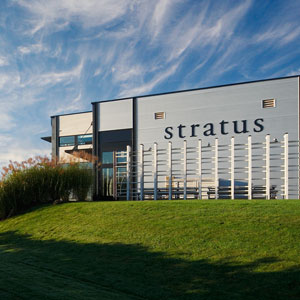What: Stratus Vineyards
Where: 2059 Niagara Stone Rd., Niagara-on-the-Lake
Tastings: 12 to 5 p.m. Wednesday to Sunday, November through April, 11 a.m. to 5 p.m., daily other months.
Proprietor: David Feldberg Winemaker:Jean-Laurent (J. L.) Groux
Specialty: The Stratus wine program revolves around two wines, the Stratus Red and the Stratus White. All other wines flow from those two grand cuvees. The winery now has a “second label” called Wildass, a more affordable alternative to the top wines.
Must try: The 2007 reds are slowly being released and are delicious all the way up the chain to the first growth Stratus Red. Since not all varietals are made in any given vintage, a wine lover is advised to try the Cabernet Sauvignon (only one made since 2004), the Gamay (last one made was 2002) and, of course, the Stratus Red 2007 and the current release Stratus Red 2006. Also, the Stratus White 2006 is drinking beautifully now.
Availability: Winery, web, limited LCBO/Vintages.
Website: www.stratuswines.com
By Rick VanSickle
Stratus winemaker J.L. Groux is a modest man.
He attributes the remarkable success of Stratus to nature and the gentle manner in which the grapes, juice and wine are treated from the vineyard to sorting to crushing and all the way to the final product.
The success of any given bottle of wine made at Stratus “is not our decision. It is nature’s decision,” says the veteran Niagara winemaker.
That may be true, but Groux is only partly right. Nature provides the raw product but it takes an artist like Groux and the entire team at Stratus to craft some of the most fascinating wines in Niagara. It starts at the top with a desire from the owner, David Felberg, to make the most enjoyable Stratus Red and Stratus White they possibly can from the best grapes grown at the Niagara-on-the-Lake estate. All other wines made at the world’s first LEED (Leadership in Energy and Environmental Design) certified winery flow from that premise.
Achieving that monumental task starts in the vineyard, says Groux.
Eighteen grape varieties are planted on 55 acres of low-yielding (an average three tonnes per acre), hand-hoed, hand-harvested vineyards.
Once the grapes are brought to Stratus they begin their journey in one of Niagara’s most innovative wineries through a gravity-flow system that eliminates the need for trucks and hard pumping that can adversely affect or damage the wine. The process starts on a hand-sorting table before the gently-crushed grapes slowly make their trek down the various levels of the winery to the fermentation tanks and barrels and finally to the all-French oak barrel room. The finished wines are then sent back to the top of the winery on an elevator for bottling and on to consumers.
But the most important step in the entire process is the time-consuming business of determining what varietal combination will make up the most treasured of Stratus wines. “Everything else we make is just a consequence of Stratus Red,” Groux says.
The Stratus Red can contain up to seven different grape varieties. Groux and his team go through a laborious three-month process involving hundreds of “blind” tastings sorting through single barrels of wine, mixing combinations from 43 different blocks of vineyards to come up with the perfect “assemblage” or blend for that particular vintage. That final recipe (Cabernet Sauvignon, Cabernet Franc, Gamay and Merlot for the 2007 vintage, for example) will determine what other red wines Stratus will make in any given vintage.
I tasted through the red wine lineup from the fascinating 2007 vintage with Groux and marketing director Charles Baker. I was struck by the beauty of these wines, the structure and purity of fruit flavours. Most won’t be released until later in the year, but here are a few to look forward to or buy now.
Wildass Red 2007 ($20, wildasswines.com, winery, LCBO, 4 stars) — This is a standalone red blend and for $20 an outstanding wine. Currants, wild berries and spice on the nose followed by juicy fruits and oak/spice notes in the mouth.
Stratus Gamay 2007 ($29, winery, web, 4.5 stars) — This is the first Gamay made since 2002. A fruit explosion on the nose that all carries to the palate. Rich, ripe fruits and spicy mocha and approachable in its youth. A star is born for this lovely varietal.
Stratus Petit Verdot 2007 ($42, winery, web, summer release, 4.5 stars) — A wonderful nose of red fruits and spice. In the mouth, the fruits are ripe with firm tannins and bright acidity. This is a perfect candidate for the cellar or to enjoy now with your favourite red meat.
Stratus Merlot 2007 ($42, winery, web, spring release, 4.5 stars) — This is only the third vintage for a 100% Merlot. The nose reveals pretty cherry/ kirsch notes with vanilla toast and sweet spices. This has it all — complexity, flavour, defined tannins, elegance and wonderful mouthfeel. Should develop nicely in the cellar.
Stratus Cabernet Sauvignon 2007 ($48, winery, web, fall release, 5 stars) — A shame we have to wait for this benchmark Cab, it’s a blockbuster. Concentrated aromas of blackberry tinged with red fruits and an array of spice and oak accents. It’s absolutely a dream on the palate with gushing black fruits built on a sturdy, structured frame and a bed of tannins that will integrate given time.
Stratus Red 2007 ($44, winery, web, fall release, 4.5-5 stars) — The flagship red assemblage, the one voted by its peers most likely to succeed, and the reason Stratus makes wine in the first place. It lives up to its billing. Though young, it’s already showing a decadent nose of persistent black fruits, cinnamon and cloves. It’s big, vibrant and powerful in the mouth yet maintains its youthful restraint. You sense with the endless finish that this is a long-lived and glorious wine.
Enjoy!







Comment here